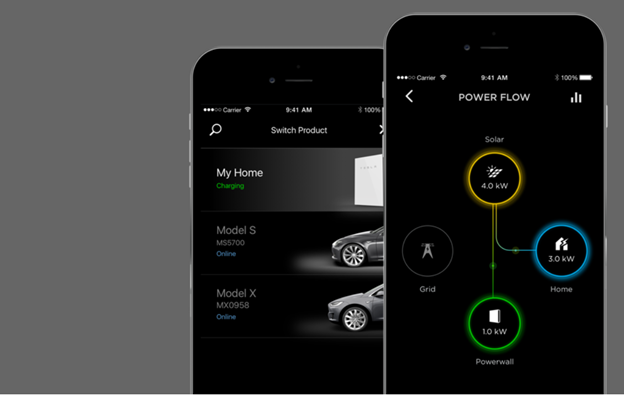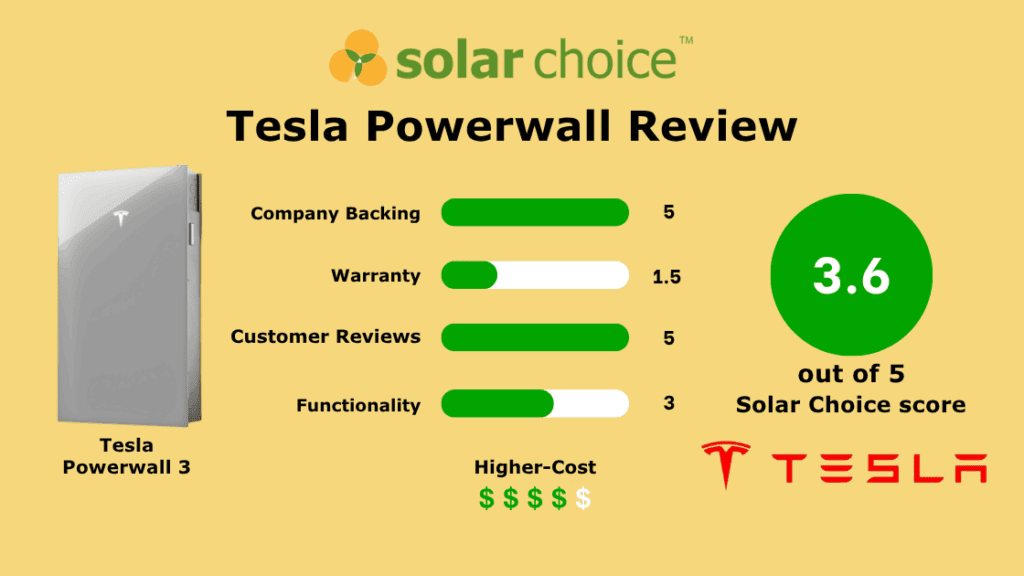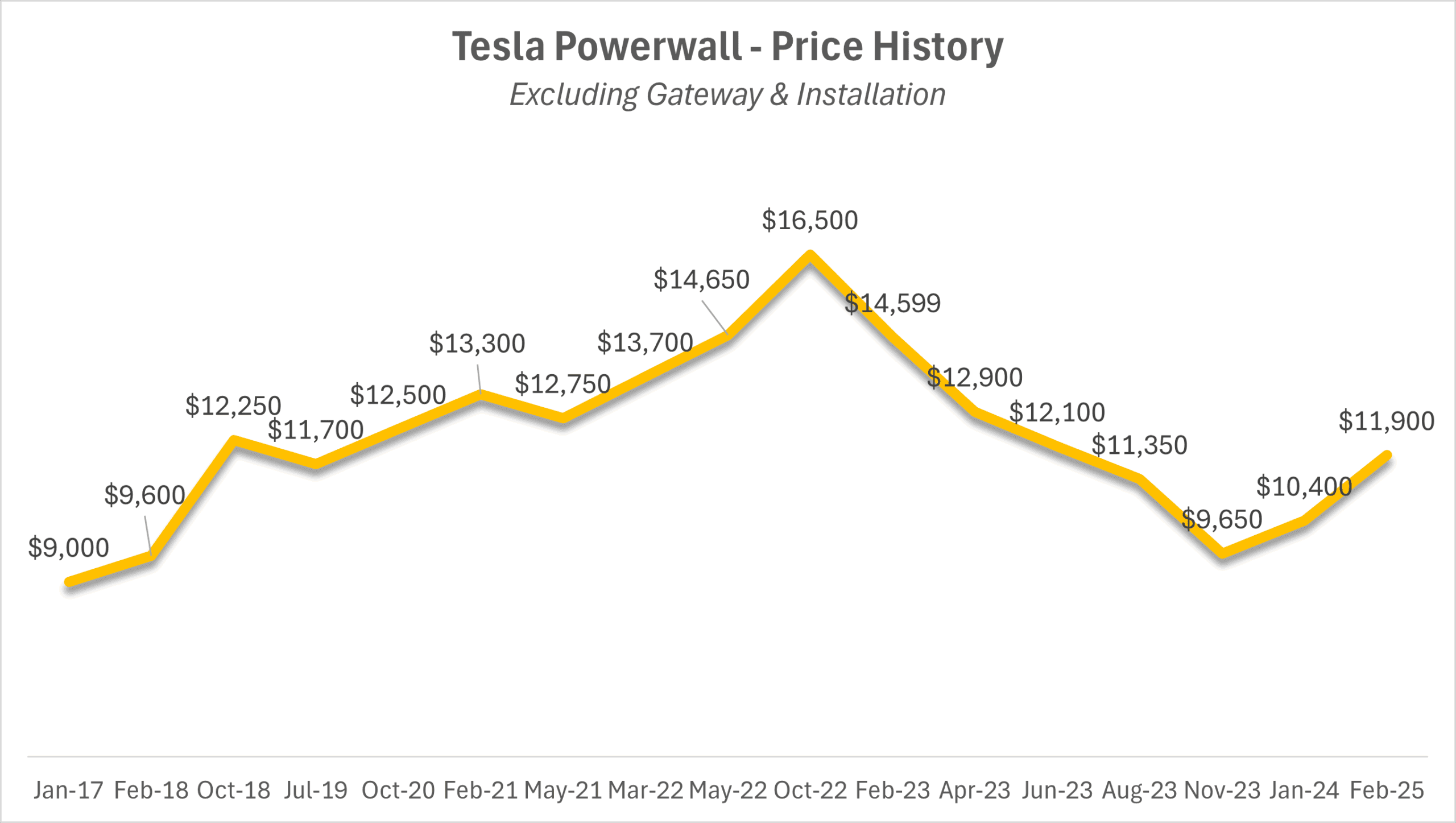Solar Choice has no reason to promote Tesla in this Tesla Powerwall 3 review and our battery articles are independent written and unbiased.
Thinking about installing a Tesla Powerwall in 2025? Here’s what you need to know. The Tesla Powerwall 3 has quickly become one of the top home battery systems in Australia, building on the success of the Powerwall 2. In this expert Tesla Powerwall review, we break down the Powerwall 3 vs Powerwall 2, current Australian prices, installation costs, rebates, updated specs, warranty coverage, and—most importantly—whether getting a Tesla battery is still worth it in 2025.
At a Glance: Tesla Powerwall 3 scores 3.6 out of 5
Scoring is based on our solar battery scorecard which is consistently applied to each brand and battery available on the Australian market. This scoring reflects Tesla’s Powerwall 2 system.
$$$ Price: Based on data from Solar Choice’s network of solar installers, the average price for an installed Tesla battery is $1,129 per usable kWh. This places it in the higher-cost price range.
- Company Backing and Trustworthiness (5 out of 5): Tesla has been operating in the Australian market since 2015 and is backed by one of the world’s largest and most recognised energy companies. The company has more than 20 staff in Australia and a long-standing global presence, earning it a perfect score in this category.
- Warranty Offer (1.5 out of 5): Tesla offers a throughput warranty of 2.8MWh per usable kWh unless only used for basic functions. It also comes with a 10-year product warranty and a maximum degradation of 30%. Despite the strength of Tesla’s brand, the throughput value results in a below-average score for warranty coverage.
- Customer Reviews (5 out of 5): Tesla batteries have received outstanding feedback from verified customers, with an average score of 4.78 from 161 reviews on Solar Choice’s independent platform. This earns a perfect score under our customer review framework.
- Functionality (3 out of 5): Tesla’s Powerwall meets most of the key functionality benchmarks. It is IP67 rated for outdoor use and includes a built-in inverter to enable an AC connection to existing solar systems. However, it lacks fire suppression and modular expansion. The battery capacity can only be expanded by adding additional full 13.5kWh batteries which is not cost effective.
Overview and History of Tesla Powerwall
How Much Does The Tesla Powerwall Cost?
Tesla Powerwall 3 Price in Australia (2025)
In 2025, the Tesla Powerwall 3 price in Australia is around $15,000 installed, based on Solar Choice’s network of over 400 accredited installers.
This installed price usually includes:
- The Tesla Backup Gateway
- Professional installation
- Delivery and required electrical components
On Tesla’s official website, the Powerwall 3 battery unit alone is listed at $11,900 (excluding installation and the gateway).
Tesla Powerwall 2 Price
The fully installed Tesla Powerwall 2 typically cost between AUD $11,900 and $13,900. The price in started at just $9,000 in 2017, making it one of the most cost-effective batteries of its time. However, high demand and rising production costs pushed the wholesale cost up to $16,500 in 2022 before rebates reduced effective prices in 2023.
Tesla Battery Cost Per kWh
Based on installer pricing, the average installed cost of a Tesla Powerwall battery is $1,129 per usable kWh, which places it at the premium end of the residential battery market.
Tesla Powerwall Price Change History (excluding Gateway):
| Date | Wholesale Price | Change |
| 2017 | $9,000 | |
| 2018 – February | $9,600 | +$600 |
| 2018 – October | $12,250 | +$2,650 |
| 2019 – July | $11,700 | -$550 |
| 2020 – October | $12,500 | +$800 |
| 2021 – February | $13,300 | +$800 |
| 2021 – May | $12,750 | -$550 |
| 2022 – March | $13,700 | +950 |
| 2022 – May | $14,650 | +$950 |
| 2022 – October | $16,500 | +$1,850 |
| 2023 – February | $14,599 | -$1,901 |
| 2023 – April | $12,900 | -$1,699 |
| 2023 – June | $12,100 | -$800 |
| 2023 – August | $11,350 (after rebate) | -$750 |
| 2023 – November | $9,650 (after rebate) | -$1,700 |
| 2024 – January | $10,400 | +$750 |
| 2025 – February (PW3) | $11,900 | +$1,500 |
Tesla Powerwall 2 Discontinued? What It Means for Australian Homeowners
With the Tesla Powerwall 3 rollout, the Tesla Powerwall 2 has been discontinued in Australia.
For the most part the Powerwall 3 offers the same or better technical specifications to the Powerwall 2 including a larger built in PV inverter.
If you’re comparing options, see our guide to the Best Solar Batteries in Australia.
What if I already have a Powerwall 2?
Unfortunately the Tesla Powerwall 3 is not compatible with the Tesla Powerwall 2 so homeowners are unable to expand existing Powerwall 2 systems. Also the Powerwall 3 model can only be expanding to 4 parallel units where as the Powerwall 2 could be expanded to 10 units.
So it seems that Tesla’s newer model is mainly focused on new solar and battery customers and was not designed with existing solar customers in mind.
The Chemistry of a Tesla Powerwall 3
Tesla Powerwall Backup Gateway
Compare solar and battery quotes from local installers now.
Tesla Powerwall 3 Pros & Cons
Pros
- Depth Of Discharge (DoD): Excellent specifications including 100% DoD.
- Retrofit Capability: Easily integrates with third-party solar inverters, making it versatile for existing solar setups.
- High Power Output: The built in inverter can provide a continuous output of 11kW which can cover pretty much any combination of major household appliances.
Cons
- Expensive: One of the most expensive battery solutions on the market
- Not designed for 3-phase applications: as you can only connect the battery to one phase.
- One size fits all: The Tesla Powerwall 3 comes in one size (13.5kWh) with a built in 10kW inverter which limits consumers ability to get the optimal battery size for their needs.
Tesla Powerwall 3 Performance Specifications
| Specification | Tesla Powerwall 3 | Relevance to Homeowner |
|---|---|---|
| Usable Capacity | 13.5 kWh | Determines how much energy can be stored and used during non-solar hours. |
| Power Output (Continuous) | 11.04 kW | Indicates how many household appliances can be powered simultaneously. |
| Power Output (Peak) | Up to 15.6 kW (3 sec) | Handles short bursts of high energy demand (e.g. motor start-up). |
| Built-in Inverter | Yes – 11 kW hybrid inverter | Simplifies installation and reduces cost by eliminating external inverter need. |
| Solar PV Input (DC Coupling) | Up to 20 kW (3 MPPTs) | Allows direct solar panel connection; ideal for new solar + battery installs. |
| AC Coupling Support | Yes – retrofit capable | Compatible with existing solar systems, preserving previous investments. |
| IP Rating | IP55 (enclosure), IP67 (battery/electronics) | Ensures safe, durable outdoor operation in all weather. |
| Battery Chemistry | Lithium Iron Phosphate (LFP) | More stable and safer than older lithium chemistries; lower fire risk. |
| Product Warranty | 10 years | Covers parts and labor defects for 10 years. |
| Performance Guarantee | 70% capacity retention after 10 years | Assures long-term performance – at least 70% capacity remains in year 10. |
| Cycle Life / Throughput Limit | Unlimited cycles (for solar/self-consumption use) otherwise 37.8MWh | Supports daily use without voiding warranty – ideal for typical household solar. |
| Fire Suppression | No dedicated suppression | No internal fire suppression, but safe design and chemistry mitigate fire risks. |
| Modularity | Expandable up to 4 units + future expansion packs | Allows future upgrades without replacing the entire system. |
| Operating Temperature Range | –20°C to 50°C | Operates reliably in extreme heat or cold – suitable for most Australian homes. |
| Installation Location | Indoor or Outdoor | Flexibility in mounting options to suit space availability. |
| Backup Gateway Required | Yes – Backup Gateway 2 | Required for monitoring, safety disconnects, and backup functionality. |
Tesla Powerwall Warranty for Australian Customers
Tesla Mobile App Functionality

- Back-Up Only: The Back-Up Only feature is designed to store all available energy in the battery, ensuring that it remains fully charged. This feature helps to ensure uninterrupted power supply to the system during blackouts. If used with a Solar PV system of sufficient size, the battery can potentially last for weeks.
- Self-powered Mode: When using the Self-Powered mode, batteries are utilized to make the most of free energy generated from rooftops. This helps reduce energy bills by using energy from the grid only when necessary. Residential batteries help homeowners manage their evening and early morning power usage.
- Time-based Control: The Tesla Powerwall has an intelligent feature that enables it to charge when electricity is cheaper, and discharge power when it’s more expensive, but only if the owner has a time-based electricity charge from their retailer. The financial benefit of this feature depends on the tariffs of the electricity retailer and is usually not enough to justify the cost of the battery system alone.
Overall Verdict On Tesla Powerwall?
How Do I Get a Tesla Powerwall Battery?
Compare solar and battery quotes from local installers now.
Tesla Powerwall Costs With Australian Solar Battery Rebates
FAQ
In 2025, a Tesla Powerwall installed in Australia typically costs $12,000–$16,000 for a standard install (before state rebates or VPP incentives). Final price varies by state, switchboard upgrades, and backup wiring. Add-ons (extra circuits or gateway work) can push totals higher; rebates can reduce out-of-pocket cost.
In 2025, a Tesla Powerwall 3 installed in Australia typically totals $12,000–$16,000 for a standard job before state rebates or VPP credits. The range reflects switchboard/backup wiring, travel, and meter work. Where rebates apply, the out-of-pocket cost can drop materially; always quote with your address and load.
Runtime depends on load: hours = 13.5 kWh ÷ average kilowatts used. At 1 kW (lights, fridge, devices) expect ~13–14 hours; at 2 kW, ~6–7 hours. Back-up time shortens with large appliances/EV charging and extends if solar is recharging the battery during daylight.
Higher upfront cost than many rivals; as a DC-coupled, inverter-integrated unit, retrofits may need solar rewiring or are not possible. Whole-home backup may require extra electrical work; supply times can vary; and like all lithium batteries it degrades over time (covered by a 10-year warranty with use limits).
- Running Cost of Air Conditioners – Explained - 7 October, 2025
- Air Conditioner Rebate South Australia: What You Need to Know - 19 September, 2025
- Air Conditioner Rebates in Queensland: What You Need to Know - 19 September, 2025
Reviews from Australians who have installed Tesla Batteries
Review left 2 years after system installed
Battery is great, monitoring app is intuitive.
Tesla Powerwall 3 (13.5 kWh) with a Expansion pack (13.5 kWh) , total 27 kWh. The unit and management 'app' are excellent and performing as per performance projections as supplied by Springers Solar. Only regret is not having installed a second Expansion pack to take the system to 40 kWh of energy storage.
Whatever you plan, do not go with Tesla Power wall 3. I have now had a Tesla Power wall 3 for about 2 months now and only have trouble. Turning of not connecting, using power from the grid even though battery is at 100% discharging the Battery to the grid during the Day for 3 cent and recharging during the night from the Grid for 42cent and the Tesla support does not even contact me to explain what’s going on. For the amount of money, I had to pay I would expect better service and customer support from Tesla. Before you go this way there are much cheaper batteries on the market that work just as good but for half the Price and a great costumer support. One very upset Tesla costumer here, I would not go this way again if it were half the price.
So far so good the app keeps us updated and the 6kw system is charging the battery to it capacity for overnight use.
13.5 power wall 2 sourced just before phasing out when other providers could not
Very happy with the battery so far, the app is simple to use. I would rather a computer program is my only complaint
The monitoring App is terrific and easy to understand.
We have 3 x Powerwall 2 batteries, with the earliest installed in 2018 and the 3rd and last one in July 2025. These are amazing batteries, that have always run trouble-free, and with the 3 now installed, we are running electricity bill free and always in credit with our electricity supplier.
The battery was installed yesterday and it is too early to determine quality, performance etc
Very happy with the battery performance and the Tesla app is easy to use and informative
Review left 3 years after system installed
Seems happy Virtual power plant algorithm Needs to be changed to better reflect my usage it will discharge before sundown only to top up with Sometimes leaves battery less than 90% Let me stress THAT Solarpro is not responsible for the VPP Virtual power plant and it’s completely out their control Ben has suggested some alternatives and I am progressing through the options I am currently considering adding more battery’s Ben listens and picks up the phone directly My rebates were made simple and with a minimum of fuss
If I could give Tesla and their Powerwall 3 zero stars I would. The PW3 battery hasn’t worked since day one. It keeps cutting off my solar supply inexplicably making my solar panels useless. It also refuses to self charge from the grid as advertised. After sales service from Tesla has been non existent. For a premium product and premium pricing Teslas product and service have been terrible. Not good enough
The battery performance is great and easy to change.
Review left 3 years after system installed
The battery stopped charging and discharging after 2 years. It took 3 months of extended work to get Tesla to replace it. Tesla is terrible for warranty service and the worst customer experience I have ever had. After 3 months operation the replacement is not charging correctly and possibly overheating.
Powerwall 3 failed after 3 months and took another 3 months to get replaced under warrenty - Worst of all if the battery fails you get no solar as the inverter in inbuilt.
Great piece of technology, good for reducing emissions and your power bill.
Purchased before I knew what I know now about Musk.
Happy so far but it gas only just been installed
Battery appears to perform well with the app allowing easy control of all functions




